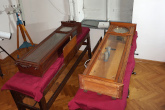Rückkehr der Originaluhren auf die Kuffner-Sternwarte
Die Präzisionspendeluhren "Kutter Nr. 47" und "Riefler Nr. 3" befanden sich jahrzehntelang auf der Universitätssternwarte. Als vor wenigen Jahren mit Recherchen zu der 1884 von Moriz von Kuffner (1854-1939) gegründeten Sternwarte begonnen wurde, war mit der "Urban Nr. 18" nur noch eine der ursprünglich drei Präzisionspendeluhren des Observatoriums vorhanden. Die Suche
nach der Kutter und der Riefler führte 2018 zu ihrer Entdeckung im Museum der Universitätssternwarte Wien.
Im Mai 2022 erfolgte durch die Universität Wien die formelle Rückgabe dieser Uhren an die rechtmäßigen Eigentümer, die Urenkel des Sternwartegründers Moriz von Kuffner. Ihre Mutter Vera Eberstadt, geb. Kuffner (1928-2014), hatte nach dem Tod ihres Großvaters das Inventar der Sternwarte geerbt.
Am 6. September 2022 wurden die Uhren in einem feierlichen Akt von der Vizerektorin der Universität Wien, Regina Hitzenberger, an Moriz von Kuffners Urenkel Michael Eberstadt auf der Kuffner-Sternwarte übergeben.
Es sprachen Vizerektorin Regina Hitzenberger, Günther Wuchterl, Leiter der Sternwarte, Verein Kuffner-Sternwarte und Michael Eberstadt. 60 Personen haben an der Feier teilgenommen.
Als Leihgabe an den Verein Kuffner-Sternwarte werden die Kutter und die Riefler auf Wunsch der Eigentümer Michael und George Eberstadt in der Sternwarte ausgestellt.
Mit der Kutter kehrte nun auch die Hauptuhr der Kuffner-Sternwarte, mit deren Hilfe der bekannte Ottakringer Sternkatalog angefertigt wurde, an ihren ursprünglichen Aufstellungsort zurück. Die Riefler-Pendeluhr war eine der genauesten Uhren ihrer Zeit.
Rede von Michael Eberstadt am 6. September 2022 auf der Kuffner-Sternwarte
Michael Eberstadt Speech, Kuffner Observatory, September 6, 2022
The occasion of the restitution of Mom’s two clocks to the Observatory
Frau Hitzenberger. Gunther. And everyone gathered here this evening. It is a great pleasure to celebrate with you all the restitution of my mother’s two astronomical clocks as well as their homecoming to the Kuffner Observatory. I want to thank the University of Vienna for agreeing to the restitution. My brother George and I could not be happier to lend them to the Observatory where they will be used for the purpose and in the place our great grandfather Moriz Kuffner originally intended over a century ago.
I would like to acknowledge and thank two women – two undeterred women - who fought for many years to make today possible: Eva Holper from the Kultusgemeinde and Klaudia Einhorn from the Observatory. They have worked tirelessly and passionately to ensure the ultimate result of the clocks’ restitution. Please join me in thanking Eva and Klaudia. On another note, I must also admit that I have always found it an odd feeling that both Eva and Klaudia know so much more about my family than I do.
I also want to thank everyone who organized this evening’s celebration. I always think of the Observatory as a place of friendship and shared values.
Today is certainly a day to celebrate, but, at the same time, it is important to acknowledge that the restitution of these clocks was only necessary because they were taken from their rightful owners during the Nazi years. Two taken things among millions of taken things. And, of course, things are only things. The real issue and tragedy is what happened to people – over two hundred thousand Austrian Jews. Among whom were members of the Kuffner family who suffered everything from forced emigration to gassing in Auschwitz. It is always incredible to think that all of that happened right here in Vienna.
That feeling of incredulity is what I want to talk about this evening. And, because I have been a decades-long struggling playwright and tend to view events as stories, I would like to consider this feeling of incredulity within a literary context. A story – like a life - has the most basic narrative structure: a beginning, a middle, and an end. Over the course of the story, we follow the character’s actions and choices. With cheer. With sadness. With frustration. But always, we see the character’s rational given the world in which the character exists. When the ending finally arrives – in a well told story – we feel that whatever the outcome – good or bad – that it was the only possible outcome. In fact, if the outcome is anything else than what it logically ought to have been, we feel the author has either made a mistake or, worse still, purposefully mislead us. We literally don’t believe what has happened.
In addition to poor writing, there is one other possible explanation for an ending that suspends our belief: the Greek literary device of a deus ex machina in which some unforeseen force impetuously inserts itself into the narrative radically changing the expected ending. My wife Nina and I recently visited Riga in Latvia. We stood next to the pits in the Rumbula Forest where over 25,000 Jews – predominantly women and children – were forced to strip naked and then slaughtered one by one in the bitter winter of 1941. Would that there had been a deus ex machina in Rumbula – a last minute flash of salvation. But, there wasn’t. Perhaps the problem was that not even the tragedy-minded Greeks could have envisioned such an event.
The Nazis’ great contribution to literature is they provided one additional device for an ending. A non sensical ending. Or, more precisely, an a-sensical ending. Because the ending of the Austrian Jewish narrative does not in any way fit with everything that had happened before for centuries. The Austrian Jews had been among the most loyal citizens filled with national pride. They made a myriad of contributions and innovations in the arts, philanthropy and science – the Kuffner Observatory being a prime example. They were of critical importance to the tax base. They desired and seemingly achieved true assimilation. Just yesterday, Eva, Nina and I were in the Dobling Cemetery paying respects to members of the Kuffner family and we were all struck by the fact that Viennese Christians and Viennese Jews are buried next to each – the very definition of assimilation. There are explanations for what happened next. We can list the forces – latent Anti- Semitism, avarice, and political opportunism - which so easily showed assimilation to be just a façade. But these forces – these explanations - still do not satisfactorily carry the narrative past 1938. We all know what happened in the end. There is no doubt about it. And, yet it remains unbelievable. But why? Why is the ending still so hard to believe?
When Primo Levi, the great Italian Holocaust memoirist, first arrived in Auschwitz – the literal end of the Jewish narrative - , a Nazi hit him for no apparent reason. Levi asked the Nazi the exact same question, “Warum.” Why. To which the Nazi replied, “Hier gibt’s kein Warum.” Here there is no why. And that, it turns out, is the correct answer for his and my own shared sense of incredulity. The answer is coarse, anti-intellectual, insipid, but spot on. If the Nazis could create a place like Auschwitz, then the Nazis could create any type of ending – no matter how unbelievable. The Nazis changed the endings of the stories of millions of Jews and others simply because they could. Simply because they wanted to.
In this Observatory, on a cloudless night, one can look deep into the sky. And one will find that all the stars are precisely where they ought to be. And, with correct math and expertise, one can also reverse their positions and chart their course backwards to their genesis. Turn around again, and, with the help of my mother’s clocks, one can predict where the stars will be a second from now or a day or a year. It is all predictable, rational, natural. Prior to 1938, one could also have watched and predicted the trajectories of the lives of the Jews of Austria. Natural lives. Filled with normal happiness and normal unhappiness. Until Amalek – the Nazis – changed everything. Then their lives would no longer be found where they ought to be. Instead, they are in Nisko, Opole, Riga, Kielce, Theresienstadt, and Auschwitz. And while not horrific and deadly, they are also found unnaturally in Switzerland, Australia, Cuba, and, for my mother and her mother, New York City. The Big Bang placed all the stars in the universe precisely where they ought to be; the Shoah did precisely the opposite for the Jews of Austria.
Stories – like lives and speeches – have endings. But sometimes with stories, there is an Afterword - a few extra pages after the formal ending. We learn how things are going for the main characters later on after the main action has concluded. That is where we are this evening. In the extra pages of the story of the Kuffner family. Here. At the Kuffner Observatory. Where we celebrate a victory. Where we remember the remarkable Moriz Kuffner. And where collectively we will write even more pages because this story will continue. Thank you.






